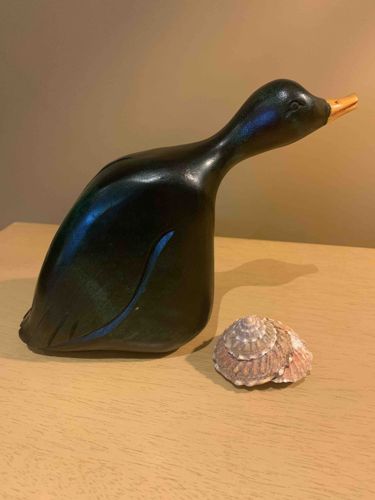
Carved Wooden Duck Decoy or Sculpture
This appears to be a hand-carved wooden duck, likely serving as a decorative sculpture or an artistic interpretation of a duck decoy. The item exhibits a sleek, stylized form, differing from a traditional, highly realistic hunting decoy. Its primary color is a very dark, almost black, iridescent green or blue-green, suggesting a deep, rich stain or paint that allows some of the wood grain to potentially show through under certain lighting, or a metallic pigment giving it a subtle sheen. The beak is painted an contrasting orange or light brown, with a smooth, slightly upturned profile. The eyes are subtly carved or painted as small, raised dots on the head. A distinct, curved blue line is painted on the side of the body, adding a decorative or abstract element to its otherwise monochromatic finish. The overall construction suggests a solid piece of wood, expertly shaped and smoothed. There are no obvious signs of significant damage like chips, cracks, or repairs visible in the provided image. The surface appears to have a consistent finish with a slight sheen, indicating good preservation. This item reflects careful craftsmanship and could date from the mid-20th century to more contemporary periods, possibly from the Quebec region given the provided context 'Guy Tainier Quebec,' though no specific maker's marks are visible. The style leans towards a modern folk art aesthetic or a more minimalist interpretation of wildlife art. The companion item in the image is a natural seashell, which is not part of the duck item itself but serves as a scale reference.
AI-Generated Appraisal Disclaimer
Estimated Value
$100-150
Basic Information
Category
Decorative Art / Sculpture
Appraised On
December 7, 2025
Estimated Value
$100-150
Additional Details Provided By Owner
User Provided Information
Guy Tainier Quebec
Item Description
This appears to be a hand-carved wooden duck, likely serving as a decorative sculpture or an artistic interpretation of a duck decoy. The item exhibits a sleek, stylized form, differing from a traditional, highly realistic hunting decoy. Its primary color is a very dark, almost black, iridescent green or blue-green, suggesting a deep, rich stain or paint that allows some of the wood grain to potentially show through under certain lighting, or a metallic pigment giving it a subtle sheen. The beak is painted an contrasting orange or light brown, with a smooth, slightly upturned profile. The eyes are subtly carved or painted as small, raised dots on the head. A distinct, curved blue line is painted on the side of the body, adding a decorative or abstract element to its otherwise monochromatic finish. The overall construction suggests a solid piece of wood, expertly shaped and smoothed. There are no obvious signs of significant damage like chips, cracks, or repairs visible in the provided image. The surface appears to have a consistent finish with a slight sheen, indicating good preservation. This item reflects careful craftsmanship and could date from the mid-20th century to more contemporary periods, possibly from the Quebec region given the provided context 'Guy Tainier Quebec,' though no specific maker's marks are visible. The style leans towards a modern folk art aesthetic or a more minimalist interpretation of wildlife art. The companion item in the image is a natural seashell, which is not part of the duck item itself but serves as a scale reference.
Get Your Items Appraised
Instant estimates of your treasures with AI-powered instant appraisals